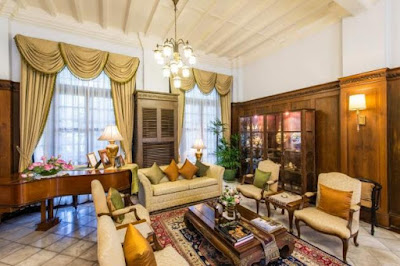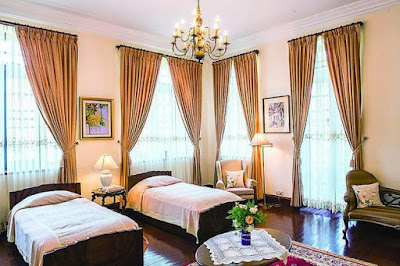A beachside resort that will appeal to anyone interested in Phuket's
past, the luxurious Indigo Pearl plays on the days when the southern
island was frequented not as a place to relax but for mining tin. A
major source of revenue from the sixteenth century right up until the
mid-1900s, tin mining eventually gave way to tourism and while the tin
culture has now gone for good, its legacy remains at Indigo Pearl
resort.
The resort is located on Naiyang Beach - a short ride north from Phuket
International Airport. The resort was revamped from the popular Pearl
Village Hotel by renowned architect Bill Bensley, founder and owner of
Bensley Design Studio, who made the most of the site's tin mining
heritage before signing off with a luxury statement.
"We wanted the overall feeling to reflect Phuket's heritage as a former tin mining centre while offering a distinctive atmosphere that will intrigue urbane travellers," says Wichit Na-Ranong, owner of the property.
"We wanted the overall feeling to reflect Phuket's heritage as a former tin mining centre while offering a distinctive atmosphere that will intrigue urbane travellers," says Wichit Na-Ranong, owner of the property.
A member of Design Hotels, the resort has been drawing guests with its
distinctive character since opening. For me, though, the attraction was
of a more edible nature. Dutch chef Richard van Oostenbrugge was the
most recent guest to grace the resort's kitchens and he gave me an
excellent excuse for a short sejour.
Van Oostenbrugge is the executive chef at the Michelin two-star Bord'Eau in the De L'Europe hotel, Amsterdam. The master chef's visit was part of the "Rolling Visits by Rocking Chefs" programme that spices up the gourmet food scene at Indigo Pearl and he was offering a six-course gourmet at the resort's flagship Rivet restaurant.
Van Oostenbrugge is the executive chef at the Michelin two-star Bord'Eau in the De L'Europe hotel, Amsterdam. The master chef's visit was part of the "Rolling Visits by Rocking Chefs" programme that spices up the gourmet food scene at Indigo Pearl and he was offering a six-course gourmet at the resort's flagship Rivet restaurant.
"Indigo Pearl has a reputation for its unique design and luxurious
hospitality," notes Christopher Oakes, the resort's general manager.
"A visit by a master chef complements both the resort and our gastronomic scene. We don't want guests to check into Indigo Pearl just to sleep - but enjoy a fine dining and hedonistic retreat."
The resort itself is stylish with the industrial-chic design evoking the former mining industry but boasting plenty of contemporary details. Its concept has a close link with the Na-Ranong Family whose predecessors were all in the tin mining industry.
"A visit by a master chef complements both the resort and our gastronomic scene. We don't want guests to check into Indigo Pearl just to sleep - but enjoy a fine dining and hedonistic retreat."
The resort itself is stylish with the industrial-chic design evoking the former mining industry but boasting plenty of contemporary details. Its concept has a close link with the Na-Ranong Family whose predecessors were all in the tin mining industry.
The room is spacious, tucked away at the far side of resort. Bensley
worked closely artist John Underwood, a native Australian and Phuket
resident in creating the unique furnishings and art pieces seen around
the room.
The bathroom boasts plain yet stylish concrete walls mixed with rustic wood poles and a modern rain showerhead in the spacious shower area. A huge outdoor bathtub is available in the "back yard".
Naiyang Beach is walking distance from my room. The sea is high when I check it out, and the beach itself less attractive than the dining table at the Rivet restaurant.
The bathroom boasts plain yet stylish concrete walls mixed with rustic wood poles and a modern rain showerhead in the spacious shower area. A huge outdoor bathtub is available in the "back yard".
Naiyang Beach is walking distance from my room. The sea is high when I check it out, and the beach itself less attractive than the dining table at the Rivet restaurant.
The Dutch master chef served his signature dishes including North Sea
crab with smoked avocado and glazed beignet, Dover sole with duck liver,
Shellfish veloute and duxelles, Red mullet and jus a Becasse and Anjou
pigeon with mustard miso. We finish with a balloon of Guanaja chocolate
coffee and praline. Beautiful.
Indigo also serves Thai food at the Black Ginger restaurant. We go there on our other night for something that's hot and spicy. The restaurant stands in the middle lagoon, and you need a boat to get there. The traditional Thai house is well made and decorated in black. The light is dim and dark and like all traditional Thai houses feels a little spooky. I find Black Ginger attractive in a gothic way. The Thai chef serves a large selection of contemporary Thai food - varying from miang (a chewy and nutty Thai snack) to famous the tomyam spicy soup.
Indigo also serves Thai food at the Black Ginger restaurant. We go there on our other night for something that's hot and spicy. The restaurant stands in the middle lagoon, and you need a boat to get there. The traditional Thai house is well made and decorated in black. The light is dim and dark and like all traditional Thai houses feels a little spooky. I find Black Ginger attractive in a gothic way. The Thai chef serves a large selection of contemporary Thai food - varying from miang (a chewy and nutty Thai snack) to famous the tomyam spicy soup.
"You better check out the wash rooms," says my friend, after a trip to
Black Ginger's facilities. I do and I'm amused by two posters telling
the difference between "Gentleman" and Lady" rooms. I won't reveal the
secret here but it's worth going out of your way to see it. Indeed, the
restroom is a destination in itself, revealing a sense of humour as much
as artistic appeal.
Indigo Pearl also serves breakfast at Tin Mine restaurant - a sort of
all-day-dining al fresco pavilion surrounded by ponds. The menu has Thai
street-style dishes - southern-style coconut curry, wagyu Thai beef
salad, grilled king prawns and chocolate fondant. I order phad kraphrao
ta-le (pan-fried squid with basil and chilli) with an egg sunny side up
on top and immediately wished I hadn't as it is swimming in oyster
sauce. Someone should remove the oyster sauce from the supermarket
shelves. Seriously. This good, old-fashioned garlicky and spicy dish has
been hard to find since the invention of a dark brown condiment made
from sugar, salt, water thickened with cornstarch and little oyster
essence.
Indigo Pearl, on the bottom line, is a stylish resort that makes a bold statement in design and space. Travellers who revel in industrial chic will love it.
Indigo Pearl, on the bottom line, is a stylish resort that makes a bold statement in design and space. Travellers who revel in industrial chic will love it.
High points: A resort with character that's located
beyond the bustling crowds of tourists in Patong. The resort is nestled
along the local Naiyang beach and boasts a community path sweeping
through a pine plantation. Beach runners will love it.
Low points: Your diet is limited to the resort's outlets and restaurants - which are expensive.
Low points: Your diet is limited to the resort's outlets and restaurants - which are expensive.
*****
For the Best #Hotels and #Resorts
We help you with your #Bookings
BOOK NOW SIMPLE CLICK ON THIS LINK ON OR THE BANNER
http://gerrit-tienkamp.blogspot.com/
http://planet-asian.blogspot.com/
https://asiabesthotels.wordpress.com/
https://europeanbesthotels.wordpress.com/
http://www.tripadvisor.com/members/Gerrit_Tienkamp
We help you with your #Bookings
BOOK NOW SIMPLE CLICK ON THIS LINK ON OR THE BANNER
http://gerrit-tienkamp.blogspot.com/
http://planet-asian.blogspot.com/
https://asiabesthotels.wordpress.com/
https://europeanbesthotels.wordpress.com/
http://www.tripadvisor.com/members/Gerrit_Tienkamp
.




















